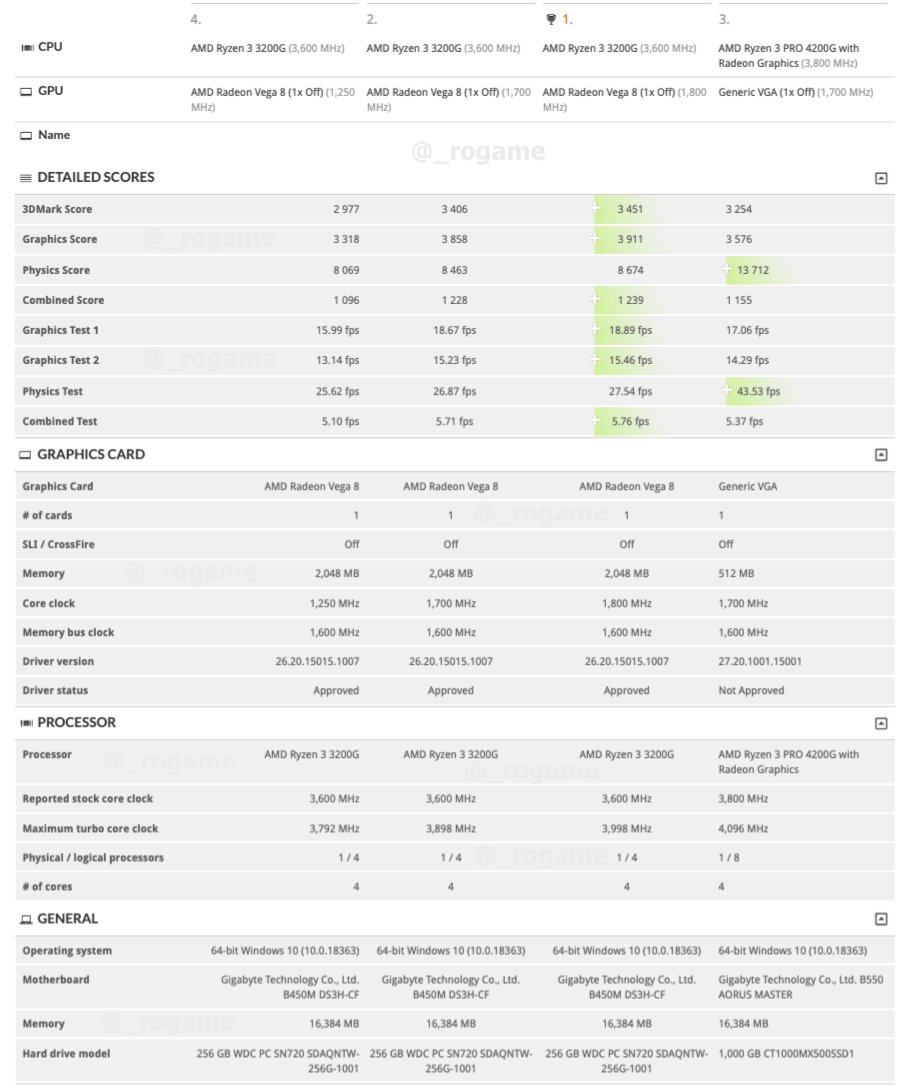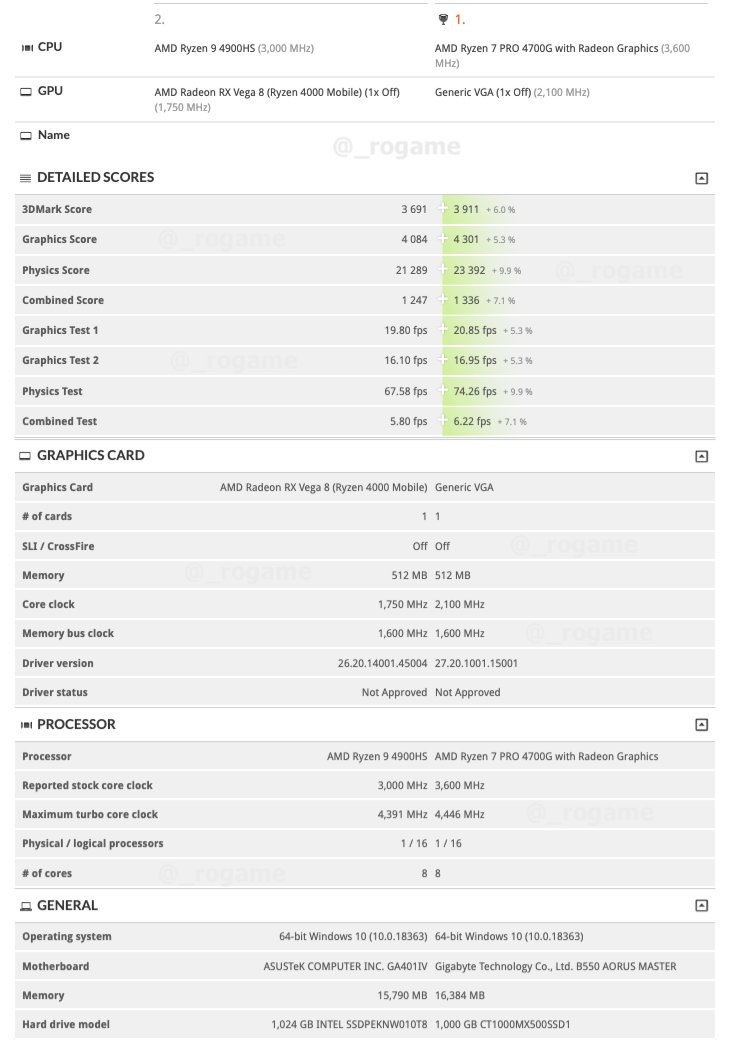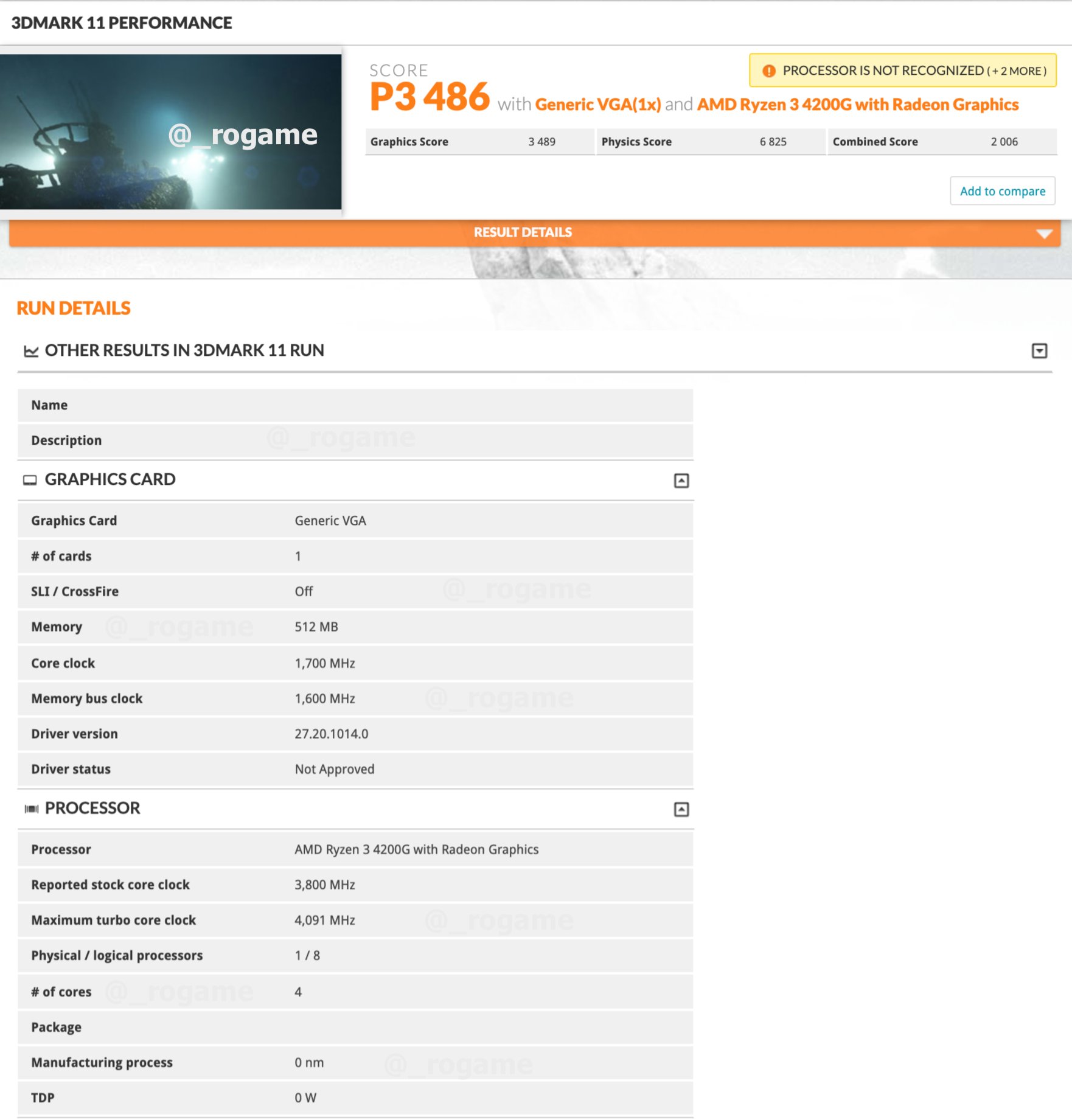AMD Ryzen 4000 Renoir Desktop Benchmarks Show Up To 90 Percent Uplift Over Last-Gen Flagship

Update: AMD has now officially launched the Renoir G-Series APUs, which you can see here.
It's been a long wait, but early benchmarks of AMD's Ryzen 4000-series (codename Renoir) Zen 2 APUs are finally out in the wild. Rising dataminer @_rogame dug up 3DMark submissions for the Ryzen 7 Pro 4700G, Ryzen 5 Pro 4400G and Ryzen 3 4200G parts.
Starting from the top to the bottom, the Ryzen 7 Pro 4700G surfaced with eight cores and 16 threads running with a 3.6 GHz base clock and 4.45 GHz boost clock. The iGPU sports eight Vega Compute Units (CUs) that are clocked at 2,100 MHz. The Ryzen 5 Pro 4400G packed six cores and 12 threads with a 3.7 GHz base clock and 4.3 GHz boost clock. The iGPU, which presumably features seven CUs, ticked at 1,900 MHz.
Last in order but not of importance, the Ryzen 3 Pro 4200G appeared with four cores and eight threads at a 3.8 GHz base clock and 4.1 GHz boost clock. The iGPU seemingly has six CUs operating at 1,900 MHz.
All three systems with the Ryzen 7 Pro 4700G, Ryzen 5 Pro 4400G and Ryzen 3 Pro 4200G were running 16GB (2x8GB) of DDR4-3200 memory in a dual-channel configuration.
AMD Ryzen 4000-Series Renoir Benchmarks
| Processor | Fire Strike Physics Score | Fire Strike Graphics Score |
|---|---|---|
| Ryzen 7 Pro 4700G | 23,392 | 4,301 |
| Ryzen 9 4900HS | 21,289 | 4,084 |
| Ryzen 5 Pro 4400G | 19,113 | 4,033 |
| Ryzen 5 3400G (iGPU @ 1,700 MHz) | 12,233 | 4,353 |
| Ryzen 5 3400G (iGPU @ 1,400 MHz) | 12,496 | 4,070 |
| Ryzen 3 Pro 4200G | 13,712 | 3,576 |
| Ryzen 3 3200G (iGPU @ 1,800 MHz) | 8,674 | 3,911 |
| Ryzen 3 3200G (iGPU @ 1,250 MHz) | 8,069 | 3,318 |
The Ryzen 7 4700G delivered up to 9.9% higher processing performance than the Ryzen 9 4900HS, which is the flagship chip for mobile Renoir. On the graphics end, the Ryzen 7 4700G's iGPU performed 5.3% better than the Ryzen 9 4900HS. The latter has the same number of CUs as the Ryzen 7 4700G, albeit with a slower 1,750 MHz clock.
One of the Ryzen 7 4700G's best assets is the greatly improved core count over the Ryzen 5 3400G, last generation's flagship SKU. The Ryzen 5 3400G system also employed 16GB (2x8GB) of DDR4-3200 memory, so it's pretty much a level playing field for both processors.
Get Tom's Hardware's best news and in-depth reviews, straight to your inbox.
The 3DMark results revealed that you can expect a performance uplift up to 91.2% from the Ryzen 7 4700G in terms of processing power. The iGPU performance between both flagships was pretty close. The Ryzen 7 4700G has three less CUs than the Ryzen 5 3400G. However, AMD makes up the deficit by clocking the CUs more aggressively – up to 2,100 MHz to be exact. The Ryzen 7 4700G beat the Ryzen 5 3400G by 5.7% in the graphics test. When the Ryzen 5 3400G's iGPU is overclocked from the default 1,400 MHz to 1,700 MHz, it outperformed the Ryzen 7 4700G's iGPU by 1.2%.





The Ryzen 5 Pro 4400G deserves a bit of the spotlight as well. The hexa-core APU performed up to 56.2% faster than the Ryzen 5 3400G. The iGPU performance is almost identical with a difference that's less than 1% between the two.
The Ryzen 3 Pro 4200G greatly benefits from AMD's decision to enable simultaneous multithreading (SMT) on the chip. With four more threads and faster clocks, the Ryzen 3 Pro 4200G pumped out 70% more performance than the Ryzen 3 3200G. The Ryzen 3 part shows the highest iGPU improvement so far by outdoing the Ryzen 3 3200G by up to 7.7%.
Overall, the preliminary results for desktop Renoir look very encouraging on the processing side. This much is to be expected since Zen 2 and the 7nm process node opened the doors to octa-core APUs. It's a shame that the iGPU performance didn't exhibit the same level of gains. That said, overclocking is still on the table, so perhaps it's still possible to squeeze some more performance out of the iGPU in that aspect.

Zhiye Liu is a news editor, memory reviewer, and SSD tester at Tom’s Hardware. Although he loves everything that’s hardware, he has a soft spot for CPUs, GPUs, and RAM.
-
chickenmcnugget I'm a bit confused by this article. I know the mobile Ryzen 4000 series chips are still zen2, but I thought the upcoming 4000 series desktop chips were all zen3?Reply -
drivinfast247 Reply
These are APUschickenmcnugget said:I'm a bit confused by this article. I know the mobile Ryzen 4000 series chips are still zen2, but I thought the upcoming 4000 series desktop chips were all zen3? -
deesider A bit disappointing - I was for a graphics increase, maybe 20 CUs for a tiny game machine.Reply -
caqde Reply
That 3400G is overclocked the stock GPU clockspeed is 1400Mhz that one was running at 1700Mhz (21% higher clockspeed). The 4400G/4700G are likley running at stock. It should also be noted that 2933 is the official stock 3400G memory speed.deesider said:A bit disappointing - I was for a graphics increase, maybe 20 CUs for a tiny game machine.
Given Zen 2's improved memory controller it should be able to use higher clocked memory at or above 3800Mhz which would improve performance. And it might be possible to clock the GPU above the 4700G's 2100Mhz.
It should be noted that a stock 3400G with 2800Mhz memory would score around ~3800 in the Graphics Test and ~4000 with 3200Mhz memory. Although it is disappointing that the leaked 4x00 series results are that close to the 3x00 series results hopefully the results will be higher when it is released. -
jeremyj_83 These will be awesome chips for use in computers like the HP Elitedesk 705 G4 Mini. My office is slowly going to these since you can mount them behind your monitor on a VESA mount. The ones we have include the 2400G and that is already decent, getting a 4400G or better would be nice for the Virtualbox VMs.Reply -
st379 TReply
The results won't be higher. The bottleneck is ddr4 not the gpu. Many benchmarks show more than 10% increase in performence with faster ddr 4.caqde said:That 3400G is overclocked the stock GPU clockspeed is 1400Mhz that one was running at 1700Mhz (21% higher clockspeed). The 4400G/4700G are likley running at stock. It should also be noted that 2933 is the official stock 3400G memory speed.
Given Zen 2's improved memory controller it should be able to use higher clocked memory at or above 3800Mhz which would improve performance. And it might be possible to clock the GPU above the 4700G's 2100Mhz.
It should be noted that a stock 3400G with 2800Mhz memory would score around ~3800 in the Graphics Test and ~4000 with 3200Mhz memory. Although it is disappointing that the leaked 4x00 series results are that close to the 3x00 series results hopefully the results will be higher when it is released.
Amd need to put HBM memory on the apu itself if you want to see ps5/xbox x level of performence.
The number of cu won't change the slow ddr 4 and will be bottlenech because of it. -
sleepyskies It is really disappointing to see the iGPU not making any marked improvements. I've been really eager build a second APU alongside my 2400G and or upgrade it, but GPU is really one of the most important things for me as far as this chips are concerned. On the CPU side of things they perform so well I wasn't really hoping for a big CPU improvement.Reply
Good on AMD for the gains made, but I'll probably be passing up this release unless reviews show promising benchmarks. -
Rdslw Reply
they are EXCEPT APU's like the one in this article.chickenmcnugget said:I'm a bit confused by this article. I know the mobile Ryzen 4000 series chips are still zen2, but I thought the upcoming 4000 series desktop chips were all zen3?
everything with gpu on chips is one gen behind. -
JarredWaltonGPU Reply
Integrated graphics has really hit the point of diminishing returns. You need a lot more memory bandwidth to feed more shader cores, and with the mainstream desktops all on dual-channel DDR4, the best you can reasonably hope for is official DDR4-3200 support. That's 51.2 GBps of theoretical bandwidth, shared between GPU and CPU use. For comparison, even a relatively low-end dedicated GPU like an RX 560 has more than double that bandwidth (112 GBps), all for the GPU.sleepyskies said:It is really disappointing to see the iGPU not making any marked improvements. I've been really eager build a second APU alongside my 2400G and or upgrade it, but GPU is really one of the most important things for me as far as this chips are concerned. On the CPU side of things they perform so well I wasn't really hoping for a big CPU improvement.
Good on AMD for the gains made, but I'll probably be passing up this release unless reviews show promising benchmarks.
So on a theoretical performance level, the RX 560 has twice the bandwidth, with CUs running at 1175 MHz. That's 2.1 TFLOPS of compute. Performance is almost double that of the Vega 11 in the Ryzen 5 3400G. The 3400G is 11 CUs at 1400 MHz, or 1.97 TFLOPS, so the majority of the performance difference is thanks to memory bandwidth.
How do you improve integrated graphics, then? You need more cores and more bandwidth. The first is easier than the second. Could you do an HBM2 stack? Sure -- Intel teamed up with AMD for such a processor with Kaby Lake G and Vega M Graphics. Performance was relatively close to an RX 570 4GB ... and the cost for the processor was more than double the cost of a 3400G.
The next-gen consoles are doing massive GPUs with CPUs, plus 16GB of GDDR6 memory. But that's a special case, as console hardware has a static spec and sells tens of millions of units, so economies of scale come into play. No CPU or GPU upgrades, static platform, etc. But no company has even attempted a PC "APU" with anything close to console levels of GPU performance and memory bandwidth. -
Rdslw Reply
Its still vega so that part would be sized like 5600XT alone. I am afraid it would end up so power hungry, you won't be able to use it in SFF.deesider said:A bit disappointing - I was for a graphics increase, maybe 20 CUs for a tiny game machine.